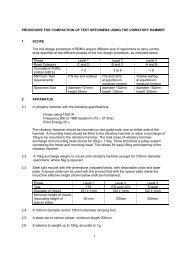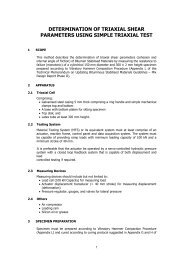Updating Bituminous Stabilized Materials Guidelines Mix Design Report Phase II
Moisture Sensitivity: Part II (Validation) - Asphalt Academy
Moisture Sensitivity: Part II (Validation) - Asphalt Academy
- No tags were found...
Create successful ePaper yourself
Turn your PDF publications into a flip-book with our unique Google optimized e-Paper software.
An electric calibration unit used to set the axle wheel load, as shown in Figure J.7. The load of<br />
the wheel in initial study set at 1.2 kN, that changed to 1.8kN for correlation with MIST device<br />
test set-up. The selected 1.8kN is equivalent to a small truck, and by tensioning the springs, the<br />
load of the wheel calibrated to the correct wheel load.<br />
CALIBRATION UNIT<br />
JUNCTION BOX<br />
ELECTRONIC DISPLAY<br />
CUT-OUT<br />
MACHINE CROSS MEMBER<br />
FLANGE A<br />
SPRING SUPPORT<br />
SPACER<br />
NUT A<br />
FLANGE B<br />
NUT B<br />
NUT C<br />
PIN WITH CIRCLIP<br />
10<br />
GUIDE WHEEL<br />
10mm GAP<br />
RUBBER STOPPER<br />
OUTLINE OF TYRE<br />
Fig.3: Measuring and setting the wheel lo<br />
Figure J.7: The calibration of the wheel load<br />
The suspension system of the wheel designed so that the vertical displacement of the wheel,<br />
within a range of less than 25mm, does not influence the pressure the wheel exerts on the<br />
specimen.<br />
The briquettes are placed in a steel beam, Figure J.15, with moulds tightened from the sides of<br />
the beam to keep the specimens restrained in one position during testing. The testing set-up<br />
however required modification. In the field, the vehicles do not drive directly on the BSM layer<br />
i.e. there is always a surfacing above it, so some protection of the surface of the BSM briquettes<br />
from ravelling is needed.<br />
In reality, the BSM layer is used in the base or subbase, so some load distribution occurs in the<br />
overlying layers, as illustrated in Figure J.8. Due to the reduction in the tyre pressures of the<br />
MMLS3 for this testing, it would be preferable if the laboratory set-up of the MMLS3 did not<br />
include a load spreading layer over the BSM because this would reduce the pore pressure<br />
induction during wheel passages. Therefore, the protection or cover should not distribute the<br />
stress over the briquettes, as shown in Figure J.9.<br />
7












